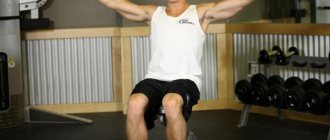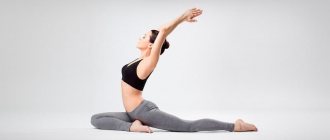August 11, 2015 Admin Home page » Anterior delta
Full description of the exercise, lifting dumbbells in front of you, muscles involved, starting position, technique, other exercises for the anterior deltoid, common mistakes and important tips + training video.
This is a classic example of an isolation exercise for deep development of the anterior deltoid muscle, therefore this exercise is aimed at “sharpening” the anterior deltoid, and not all deltoid muscles, therefore, critical weight as in basic exercises is excluded.
Technique for lifting dumbbells in front of you
Take a deep breath and, as you exhale, lift the dumbbell in front of you to eye level, while the elbow at the top point should not be lower than the level of your shoulders, otherwise the effectiveness of the entire movement will be lost. When the dumbbells rise to shoulder level, they should be shifted slightly inward until the end of the movement, increasing the isolated load on the muscle being trained.
You should not linger at the top point, but having reached the peak of contraction of the anterior deltoids, return to the starting position, avoiding the dumbbell touching the quadriceps.
For maximum muscle contraction, lift the barbell above head level by about 10 cm, in this position the muscle experiences the so-called “super stress” and awakens the deepest parts of the anterior deltoids.
Rear deltoids
With good development, the posterior fascicles of the deltoids are the most massive compared to the other fascicles and give the deltas a rounded and complete appearance. The rear deltoids are involved in almost all lat pulldowns, which are the basic exercises for them. Therefore, those who like to work on their back usually do not have problems with their rear deltoids. However, there are some nuances here too.
For example, let’s take the thrust of a horizontal block. In this basic exercise for the latissimus dorsi, the rear deltoids, among many other muscles, work as synergists. The elbows are as close to the body as possible. However, as soon as we begin to spread our elbows to the sides, the load on the lats will decrease, and on the rear deltoids will increase, and will take its maximum value when the elbows are raised to shoulder level, perpendicular to the body.
Since the rear deltoids are obviously inferior in strength to the widest ones, the weight on the block will have to be reduced by half, or even more. Let's look at several exercises for the rear deltoids in more detail.
HORIZONTAL BLOCK ROD
Starting position: sitting in front of the lower block, holding a straight handle in your hands, wide grip, overhand or parallel, elbows raised up and perpendicular to the body. We raise the wheel of the lower block to chest level. Pull the handle toward you until it touches your upper chest. The movement occurs in a plane parallel to the floor.
Execution options: using a cable handle, pulling the lower block while standing in an inclined position, pulling the upper block while standing.
DUMBBELL ROAD LYING ON AN INCLINE BENCH
Starting position: lying face down on a bench with a slight inclination angle, dumbbells are located in a line and are in freely lowered hands. Raise the dumbbells to chest level, bending and spreading your elbows out to the sides as much as possible.
LIFTING DUMBELLS (MAHI) THROUGH THE SIDES IN AN INCLINE
Starting position: standing, the body is tilted forward, the dumbbells are located in a line and are in freely lowered hands. Without bending your elbows, we spread them to the sides, lifting the dumbbells as high as possible, keeping the angle between the elbows and the body at 90 degrees. To increase stability, many people rest their head on a stationary object, such as a bench.
A common mistake when performing this exercise is to hold the dumbbells parallel to each other. We recall the above rule and understand that in this version the middle deltoids are involved in the work. But in order to pump up the middle deltoids, we don’t have to bend over and create additional difficulties, right?
The second typical mistake in this, and in the previous exercise, is reducing the angle between the elbows and the body, that is, raising the elbows not to the sides, but partially back. By doing this, we reduce the load on the deltoids by connecting the latissimus dorsi muscles.
Execution options: sitting on a bench and resting your body on your hips, swing on the lower blocks.
ARM BREAKS ON UPPER BLOCKS
Starting position: standing between the upper blocks, the right hand holds the handle of the left block, the left - the right, hands are in front of the eyes. It will be more convenient to remove the handle altogether and hold directly on the carabiners, then the hands themselves will take the desired position in line. We spread our arms to the sides, keeping them slightly bent. During movement, we do not change the angle at the elbows, otherwise part of the dynamic load will go to the triceps. execution options: unilateral arm raises on the upper blocks.
Of course, in this review we could not cover the entire range of exercises for the deltoids. Outside the scope of the article were various behind-the-back rows, bench presses, reverse flyes in machines, and many other exercises that were not included in the top 10 above. The author did not set out to present all the exercises here. As the classic said, you cannot embrace the immensity. Here are the most popular, accessible and effective, according to the author, exercises. After all, there are barbells, dumbbells and block exercise machines in almost any gym.
HOW AND WHEN IS IT BETTER TO TRAIN DELTOIDS?
Beginners and intermediate athletes usually train the deltoids with some other muscle group, such as the legs. As you train, gain muscle, work weights and your ambitions, it becomes necessary to pay more attention to the deltoids. Many advanced athletes devote a separate workout to training their deltoids. Others break deltoid training into parts and train each of them with a large muscle group.
For example, rear deltoids after back training, front deltoids after chest training, and middle deltoids after quadriceps training.
There are a lot of options, as long as they bring results. Typically, the training of each deltoid bundle includes one or two basic exercises and one or two isolated ones. When performing basic and especially isolated exercises on the deltoids, it is important not to chase the weight, but to feel their work. The result in this case is determined not by the number of plates on the bar or on the block, but by the mirror. Help others - share information!
Common mistakes
1) When lifting dumbbells, the torso leans back strongly, don’t do this, you throw up the weight due to the swinging of the body and
pull with the help of the chest muscles, thus stealing most of the load from the delta;
2) After lowering the weight from the top point, the dumbbells touch the quadriceps, reducing delta tension + the dumbbell springing from the hip facilitates the initial stage of the movement (it’s good, it becomes easier, but our task is not easy, but to work the muscle and give it muscle growth).
Raising the disc while lying head down on a bench - technique for performing the exercise:
- Lie head down on a bench. The edge of the bench should run along the chest line - this is necessary to achieve the greatest effectiveness of the exercise.
- The disc should be on the back of your head, hold it with your hands. We recommend starting the exercise with a 2.5 kg disc and increasing the weight as your neck muscles strengthen.
- As you inhale, lower your head down (as if saying “yes”).
- As you exhale, lift your head up, slightly above the middle position. You should not raise your head too much, as this, firstly, is dangerous to health, and secondly, because the load is transferred to the lower groups of neck muscles.
- Perform this exercise slowly, without sudden movements.
Important Tips
1. Try not to allow your torso to sway, this will make the exercise easier, but will remove the load from the front deltoid, which means the effectiveness of the exercise will decrease.
2. At the beginning of the movement from the bottom point, you can turn your palms towards each other in advance and do the exercise in this manner, in this case the load will transfer to the inner part of the front delta.
3. Another type of exercise is when, in the process of moving the dumbbells upward, the hand turns and the palm looks inward; when they drop to the lowest point, the dumbbell turns to its normal starting position, i.e. the grip below is directed towards the body.
4. It doesn’t matter if you raise or lower the dumbbell, keep your elbows slightly bent, this removes the load from the elbow joints and concentrates the entire load on the front deltoids.
5. If you can’t balance your torso and it continues to sway, lean your back against the wall, it will not allow you to lean back and you will immediately feel how hard it is to lift each dumbbell.
6. Raise the weight slightly above the shoulders, this is how the contraction peaks and muscle failure is achieved.
And finally, I’ll say, DON’T BE LAZY TO STRETCH YOUR MUSCLE, at one time I pulled my anterior bundle and suffered from pain for a long time for 6 months. It’s a terrible feeling when it’s very problematic to abduct your shoulder, do a bench press, do simple arm curls, pull-ups and parallel bars, so I had to take less weight and come up with analogue exercises. Better spend the extra 5 minutes, but believe me, it's worth it!
Ten super exercises for shoulders
We all use the same exercises to develop our shoulders. You know - these are the basic movements, such as dumbbell and barbell presses, as well as lateral raises. They are all great at building size, but what about the overall development, shape and roundness of the deltoids? These muscles are involved in almost all upper body exercises. They help you perform movements for your chest, back, biceps, and even get a stretch from barbell squats. The deltoid includes three heads - anterior, middle and posterior, and its development requires attention to all three segments. The following little-known shoulder exercises involve the entire shoulder girdle, so I highly recommend training your shoulders in a separate session.
In case of continuous tension, the shoulders get tired very quickly. Maintaining constant tension in the shoulders during these movements causes intense muscle burning, which contributes to increased strength. Variations on standard exercises do a great job, but you rarely see people doing them. That is why they are little known.
The following ten unusual shoulder exercises, due to their uniqueness, allow you to load the anterior, middle and posterior heads of the deltoids with little stress on the trapezius.
1. Raises the disc from the bar in front of you.
This is my favorite. Start with a 5 kg disc. Personally, I work with a 10-pound plate for three sets of eight reps. Grasp the disc by the edges and perform three sets of eight reps. In this exercise, it is possible to intensify the load. How? Moving your hands from the middle of the disc towards the top edge will make the movement much more difficult.
2. Single dumbbell raises.
Instead of using a barbell or two dumbbells for front raises, use just one dumbbell. Everything is simple, but only until you start. With both hands, grab the dumbbell by the discs and lift it forward to eye level until your straight arms reach parallel to the floor. When the repetitions become difficult, you can help yourself slightly by bending your knees. However, you should not lean forward and lean back. Start with three sets of 10-12 reps and increase the weight in 5-pound increments.
3. Raise your arms forward on a low block with a rope handle.
Stand with your back to a low block, grab the rope handle and stand up straight. Start with your hands at groin level and raise your arms forward until they are parallel to the floor. When your muscles begin to tire, avoid the temptation to help yourself with your core - keep it motionless throughout the exercise. Start with one set of 20 reps and finish with two sets of 15 reps, increasing the resistance with each set.
4. Raise your arms forward while sitting on an inclined bench.
Both dumbbells and a light barbell can be used here. The grip can be different - from shoulder width to 15-20 cm. The tilt of the back should be 45°. Avoid cheating in these exercises and always move the dumbbells or barbell smoothly and under control.
5. Raise your arms forward while standing on an incline.
This is a very unusual shoulder exercise, and it hits the front and middle deltoids hard. By bending the body forward, the trapezius and upper back muscles are also actively involved in the work. Take two dumbbells, bend your knees, arch and lock your back, and lean forward at the waist until your torso is almost parallel to the floor. Hands with dumbbells are lowered down. Slowly raise your arms forward to head level. Choose dumbbells that are light enough to perform four sets of ten reps.
6. Raise your arms forward while lying down.
This is a variation of the previous exercise in which you cannot help yourself by cheating. Lie face down on a bench with your head protruding beyond the edge. Choose a bench high enough so that your arms down do not reach the floor. Take a pair of very light dumbbells and lift them forward and up (palms facing down) until they are parallel to the floor. At the top, tighten your deltoids for a second and then slowly lower the dumbbells down, keeping tight control of the movement. If you want to do a couple extra reps without cheating, ask a partner to help you. Perform four sets of 12 reps.
7. Raises arms to the sides on blocks.
Stand in front of the crossover and grab the rope handle of the corresponding low pulley with each hand. Spread your arms out to the sides, making sure your thumbs are pointing up. Avoid jerking and swinging your body. Stand up straight. Arms should be straight without bending at the elbows. Perform four sets of 12 repetitions.
8. Raises your arms to the sides with barbells.
In this exercise, instead of dumbbells, you will have barbells in your hands. Easy, right? However, you will quickly realize that not everything is so simple. The exercise can be performed both standing and sitting. Either way, this is probably the most difficult movement of all. Take a straight bar in each hand and make sure that your arms are straight, that is, your thumbs should be facing forward and the bar should be parallel to the floor. Achieving this will not be easy. Do three sets of 20 reps – if you can.
9. Raises your arms to the sides on an inclined bench.
This movement loads the rear heads of the deltoids, ensuring harmonious development of the shoulders. Sit on a bench facing the back, inclined to the floor almost to a horizontal position. Grab the handles of opposite low pulleys so that the cables intersect under the backrest, and turn your elbows outward. Raise your arms forward and outward as high as possible, moving them slightly forward and squeezing the back heads of your deltoids. Return to the starting position and repeat. Perform 3-4 sets of 8-12 reps.
10. Seated arm raises.
Sit on a bench and grasp the handles of opposite high pulleys so that the cables intersect in front of your face. Extend your arms back and down. To make the movement more challenging, keep your arms fully extended. Perform three sets of 12-15 reps.
Rakushin Anton











